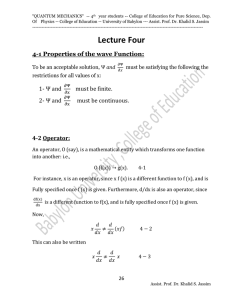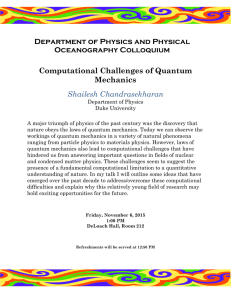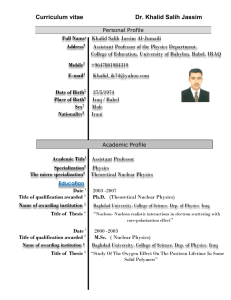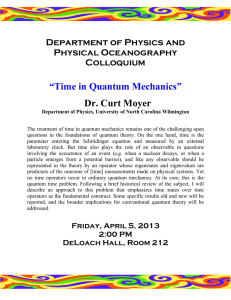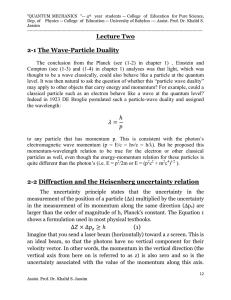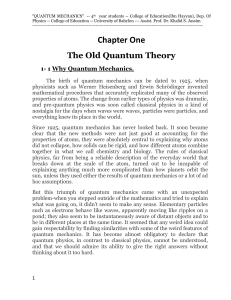Document 12524780
advertisement
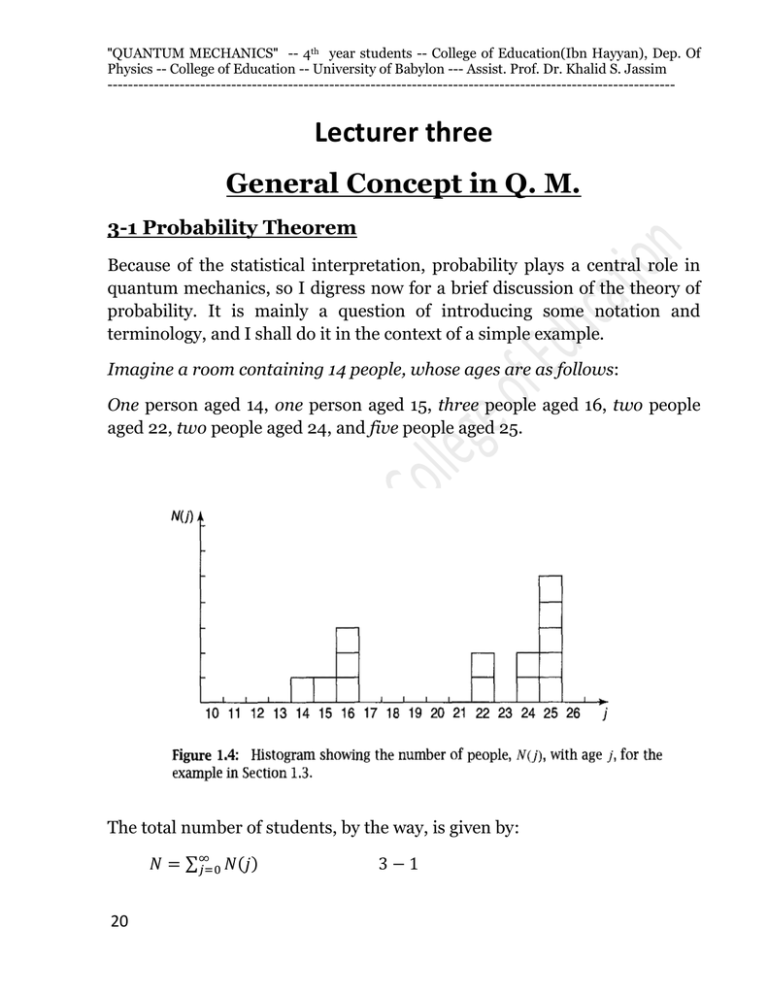
"QUANTUM MECHANICS" -- 4th year students -- College of Education(Ibn Hayyan), Dep. Of Physics -- College of Education -- University of Babylon --- Assist. Prof. Dr. Khalid S. Jassim -------------------------------------------------------------------------------------------------------------- Lecturer three General Concept in Q. M. 3-1 Probability Theorem Because of the statistical interpretation, probability plays a central role in quantum mechanics, so I digress now for a brief discussion of the theory of probability. It is mainly a question of introducing some notation and terminology, and I shall do it in the context of a simple example. Imagine a room containing 14 people, whose ages are as follows: One person aged 14, one person aged 15, three people aged 16, two people aged 22, two people aged 24, and five people aged 25. The total number of students, by the way, is given by: ∑ 20 () "QUANTUM MECHANICS" -- 4th year students -- College of Education(Ibn Hayyan), Dep. Of Physics -- College of Education -- University of Babylon --- Assist. Prof. Dr. Khalid S. Jassim -------------------------------------------------------------------------------------------------------------- Where N (j) = number of times the value j occurs. To find the mean or average value (value of age): ∑ ⟨⟩ () () ∑ Where p (j) is the probability ⟨⟩ ( ) ( ) ( ) ( ) ( ) ( ) The average of the squares of the ages: ⟨ ⟩ ∑ () In general, the average value of some function of j is given by: ⟨ ( )⟩ ∑ () () ⟨( ) ⟩ This quantity is known as the variance of the distribution; itself (the square root of the average of the square of the deviation from the average-gulp!) is called the standard deviation. The latter is the customary measure of the spread about . There is a useful little theorem involving standard deviations : ⟨ ⟩ 21 ⟨⟩ "QUANTUM MECHANICS" -- 4th year students -- College of Education(Ibn Hayyan), Dep. Of Physics -- College of Education -- University of Babylon --- Assist. Prof. Dr. Khalid S. Jassim -------------------------------------------------------------------------------------------------------------- Where 3-5 provides faster methods for computing Since is plainly nonnegative ⟨ ⟩ ⟨ ⟩ and the two are equal only when a = 0, which is to say, for distributions with no spread at all (every member having the same value). Probability that individual (chosen at random) lies between x and (x+dx) Probability = ( ) The proportionality factor, ρ(x), is often loosely called “the probability of getting x," but this is sloppy language; a better term is probability density. The probability that x lies between a and b (a finite interval) is given by the integral of ρ(x): ∫ ( ) And the rules we deduced for discrete distributions translate in the obvious way: ∫ ( ) ⟨ ⟩ ⟨ ( )⟩ ⟨( 22 ( ) ∫ ∫ ( ) ( ) ) ⟩ ⟨ ⟩ ⟨ ⟩ "QUANTUM MECHANICS" -- 4th year students -- College of Education(Ibn Hayyan), Dep. Of Physics -- College of Education -- University of Babylon --- Assist. Prof. Dr. Khalid S. Jassim -------------------------------------------------------------------------------------------------------------- 3-2 Normalization The probability of finding the particle between x and (x+dx), at time t: | ( )| It follows (Equation 1.16) that the integral of | | must be 1 (the particle's got to be somewhere): ∫ | ( )| The wave function in this case is called “normalized wave function”, and above equation is called “normalization condition”. If the wave function is not normalized, then it must be multiplied by a multiplicative constant N, and using the normalization to find N. 3-3 Probability Current density Schrödinger equation: ( ) ( ) ( ) ( ) ( ) ) ( ) ( ) Complex conjugate: ( By multiply the first by 23 ( ) ( ) and the second equation by and subtract: "QUANTUM MECHANICS" -- 4th year students -- College of Education(Ibn Hayyan), Dep. Of Physics -- College of Education -- University of Babylon --- Assist. Prof. Dr. Khalid S. Jassim -------------------------------------------------------------------------------------------------------------- [ ] [ ( ] ( ] ) ( [ ( ) ) | | ( ) ) ( ) ( ) ( ) Equation (3-17) is the Equation of Quantity, has the familiar form associated with the conservation of flow of a fluid of density P (eq. 3-18) and probability density, Sx (eq. 3-19). 3-4 The time independent Schrödinger Equation If the potential V is a function of x alone, then the wave function ( ) can be written as a product of a function of x times a function of t, that is solutions of the form: ( ) ( ) ( ) ( ) ( ) From Sch. Eq. ( ) 24 ( ) ( ) () ( ) ( ) "QUANTUM MECHANICS" -- 4th year students -- College of Education(Ibn Hayyan), Dep. Of Physics -- College of Education -- University of Babylon --- Assist. Prof. Dr. Khalid S. Jassim -------------------------------------------------------------------------------------------------------------- ( ) ( ) ( ) The left side of the equation dependence only on the variable x, the right side depends only on the variable t. since x and t independent variable. Both sides must be equal to a quantity which depends on neither x nor t in order that the equality of the left and right sides of the equation can be true for arbitrary values of the variables. Thus both sides must be equal to the same separation constant, C, that is: ( ) ( ) [ ] ( ( ( ) ) ) ( ) ( ) ( ) ( ) ( ( ) ) ( ) ( ) ( ) Where ( ) , and equation (3-24) represent the Time Independent Schrödinger Equation (TISE). 25 "QUANTUM MECHANICS" -- 4th year students -- College of Education(Ibn Hayyan), Dep. Of Physics -- College of Education -- University of Babylon --- Assist. Prof. Dr. Khalid S. Jassim -------------------------------------------------------------------------------------------------------------- Problems 1- for the distribution of gases in the example in section (3-1), a) compute ⟨ ⟩ ⟨⟩ b) Determine for each j, and use equation (3-5) to compute the standard deviation. c) use your result in (a) and (b) to check equation (3-6). 3-9 26 "QUANTUM MECHANICS" -- 4th year students -- College of Education(Ibn Hayyan), Dep. Of Physics -- College of Education -- University of Babylon --- Assist. Prof. Dr. Khalid S. Jassim -------------------------------------------------------------------------------------------------------------- 27


